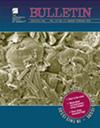Tracing Oligocene−Miocene source-to-sink systems in the deep Levant Basin: A sandstone provenance study
IF 3.9
1区 地球科学
Q1 GEOSCIENCES, MULTIDISCIPLINARY
引用次数: 0
Abstract
The Levant Basin in the Eastern Mediterranean contains an ∼3-km-thick, predominantly siliciclastic section of Oligocene−Miocene age, which hosts large hydrocarbon reservoirs (“Tamar Sands Play”). Here, we present a provenance study of Oligocene−Miocene sandstones based on detrital zircon U-Pb-Hf and heavy mineral assemblages. Samples were retrieved from four boreholes across the Levant Basin: Myra-1, Dolphin-1, Leviathan-1, and Karish North-1. Our investigations revealed that the sediments are dominated by Neoproterozoic and older Precambrian zircons with variable Hf isotopic composition, indicating that they were mainly reworked from Paleozoic−Mesozoic sandstones of African-Arabian provenance, with minor derivation from the Neoproterozoic basement of the Arabian-Nubian Shield. Variations in the proportions of pre−900 Ma zircons were encountered in various levels of the siliciclastic section. These zircons were markedly enriched (44%−57%) in the Rupelian and Aquitanian−Burdigalian intervals, accompanied by abundant detrital apatite peloids in the heavy mineral fraction, and relatively sparse (21%−38%) in the Chattian−Aquitanian and Langhian−Tortonian intervals, alongside scarce Mesozoic−Cenozoic zircons. These findings allow us to associate the deep-basin detrital record with two sedimentary transport systems that reached the Levant Basin from both NE Africa and Arabia simultaneously until the late Miocene, when sediment transport from Arabia ceased. While Rupelian and Aquitanian−Burdigalian sediments, including the main section of the “Tamar Sands,” were derived mainly from Arabian sources via the Levant continental margin, Chattian−Aquitanian and Langhian−Tortonian sediments were primarily sourced from NE Africa via the Nile Delta. Detrital contribution from the Eurasian side of the Eastern Mediterranean was not identified, suggesting that sand originating in the Arabia-Eurasia collision belt did not reach the Levant Basin.深黎凡特盆地渐新统—中新统源汇体系示踪:砂岩物源研究
地中海东部的黎凡特盆地包含一个约3公里厚、主要为渐新世-中新世时代的硅化碎屑岩段,该段拥有大型油气藏(“Tamar Sands Play”)。在此,我们基于碎屑锆石U-Pb-Hf和重矿物组合对渐新世-中新世砂岩进行了物源研究。从黎凡特盆地的四个钻孔中提取了样本:Myra-1、Dolphin-1、Leviathan-1和Karish North-1。我们的调查表明,沉积物主要由新元古代和较老的前寒武纪锆石组成,具有可变的Hf同位素组成,表明它们主要由非洲-阿拉伯来源的古生代-中生代砂岩改造而来,少量衍生自阿拉伯-努比亚地盾的新元古代基底。在不同级别的硅化碎屑剖面中,前900 Ma锆石的比例发生了变化。这些锆石在卢比安阶和阿基坦阶-布尔迪加利安层段中显著富集(44%−57%),重矿物组分中伴有丰富的碎屑磷灰石球粒,在查特阶-阿基坦阶和朗吉安阶-托托阶层段中相对稀疏(21%−38%),同时还有稀缺的中新生代锆石。这些发现使我们能够将深盆碎屑记录与两个沉积输移系统联系起来,这两个系统同时从非洲东北部和阿拉伯到达黎凡特盆地,直到中新世晚期,阿拉伯的沉积物输移停止。卢比安和阿基坦-布尔迪加利安沉积物,包括“Tamar Sands”的主要部分,主要来自通过黎凡特大陆边缘的阿拉伯来源,而查特-阿基坦和朗希安-托尔托尼亚沉积物主要来自通过尼罗河三角洲的非洲东北部。东地中海欧亚一侧的碎屑贡献没有确定,这表明源自阿拉伯-欧亚碰撞带的沙子没有到达黎凡特盆地。
本文章由计算机程序翻译,如有差异,请以英文原文为准。
求助全文
约1分钟内获得全文
求助全文
来源期刊

Geological Society of America Bulletin
地学-地球科学综合
CiteScore
9.30
自引率
8.20%
发文量
159
审稿时长
4-8 weeks
期刊介绍:
The GSA Bulletin is the Society''s premier scholarly journal, published continuously since 1890. Its first editor was William John (WJ) McGee, who was responsible for establishing much of its original style and format. Fully refereed, each bimonthly issue includes 16-20 papers focusing on the most definitive, timely, and classic-style research in all earth-science disciplines. The Bulletin welcomes most contributions that are data-rich, mature studies of broad interest (i.e., of interest to more than one sub-discipline of earth science) and of lasting, archival quality. These include (but are not limited to) studies related to tectonics, structural geology, geochemistry, geophysics, hydrogeology, marine geology, paleoclimatology, planetary geology, quaternary geology/geomorphology, sedimentary geology, stratigraphy, and volcanology. The journal is committed to further developing both the scope of its content and its international profile so that it publishes the most current earth science research that will be of wide interest to geoscientists.
 求助内容:
求助内容: 应助结果提醒方式:
应助结果提醒方式:


